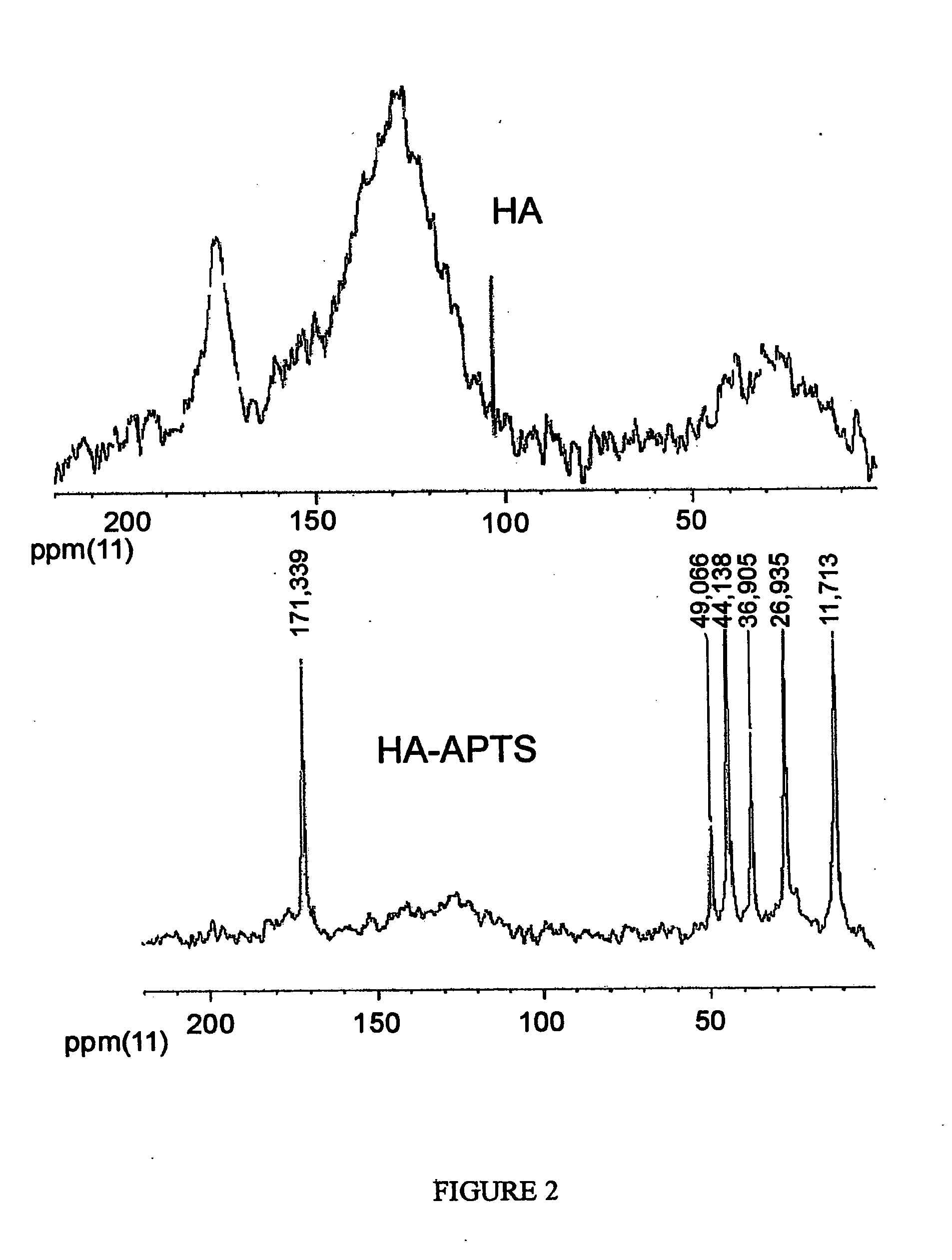Humic Derivatives Methods of Preparation and Use
a technology of humic derivatives and derivatives, applied in the field of humic and organoelemental compounds, can solve the problems of inability to meet practical needs, insufficient utilization of humics-rich materials, and inability to meet current practical needs, so as to facilitate immobilization, easy polymerization, and high humic content.
- Summary
- Abstract
- Description
- Claims
- Application Information
AI Technical Summary
Benefits of technology
Problems solved by technology
Method used
Image
Examples
example 1
[0037]Examples 1-3 describe syntheses of the novel humic derivatives. The composition and structure of the obtained derivatives are confirmed using elemental analysis, titrimetry, MK and 13C NMR-spectroscopy. The data on elemental and functional composition of the obtained derivatives are given in Tables 2-7, FTIR and 13C NMR spectra are shown in FIGS. 1-4.
[0038]This example describes synthesis of alkoxysilyl-humic derivative using organosilane carrying amino-functional group and leonardite humic acids in protonated form as starting material. The reaction was carried out in a three neck reaction vessel equipped with a stirrer, a thermometer, and a reflux condenser. A weight of leonardite humic acid (1 g) was placed into the reaction vessel and added with 60 mL of dimethylformamide (DMF), and then added dropwise under continued stirring with 1 mL of 3-amino-propyltrimetoxy-silane (APTS). The given molar ratio of reagents accounted for 1:1, while 1 g of HS used contained 3.6 mmol of c...
example 2
[0043]This example describes synthesis of alkoxysilyl-humic derivatives using organosilane carrying epoxy-group and potassium salt of leonardite humic acids as starting humic material. The same reactor was used as described in Example 1. 3-glycidoxy-propyltrimethoxy-silane (GPTS) (1.1 mL) was added to suspension, which consisted of 1 g of solid humate (K+) and 50 mL of dimethylsulfoxide (DMSO). The reaction was carried out for 10 hours at 40° C. After the reaction was completed, DMSO was vacuum evaporated. The obtained derivative was dried in a vacuum oven (40° C., 1 mbar). Yield of the reaction product was 1.81 g. The product was stored in desiccator. Structure of the obtained derivative was confirmed using elemental analysis and titration (Tables 4 and 5), and FTIR spectroscopy (FIG. 3).
TABLE 4Elemental composition on ash free basis (% mass) ofparental and GPTS-treated humic materials from leonarditeSampleCHNSiPotassium humate (leonardite)57.44.221.681.32GPTS-HA54.45.031.394.87
TAB...
example 3
[0045]This example describes alkoxysilylation of hydroquinone-enriched leonardite humic acids (HQ). HQ is the product of formaldehyde condensation of leonardite HA with hydroquinone obtained as described in Perminova et al. (2005). The HQ is enriched with hydroquinone moieties as compared to HA. 3-aminopropyltrimethoxysilane (APTS) (0.4 mL) was added to suspension of 0.4 g of solid hydroquinone-enriched HA (HQ) in 40 mL of DMF. The reaction was carried out for 20 hours at 120° C. Then DMF was vacuum-evaporated and the obtained product was dried in vacuum oven (40° C., 1 mbar). Yield of the product was 0.68 g. Structure of the obtained derivative was studied using elemental analysis and titration (Tables 6 and 7), and FTIR spectroscopy (FIG. 4).
[0046]The data on elemental composition show a substantial increase in Si content in the derivative as compared to the parental material; the data on functional group composition show a substantial decrease in both carboxylic and total acidity...
PUM
| Property | Measurement | Unit |
|---|---|---|
| Ri | aaaaa | aaaaa |
| wt. % | aaaaa | aaaaa |
| wt. % | aaaaa | aaaaa |
Abstract
Description
Claims
Application Information
 Login to View More
Login to View More - R&D
- Intellectual Property
- Life Sciences
- Materials
- Tech Scout
- Unparalleled Data Quality
- Higher Quality Content
- 60% Fewer Hallucinations
Browse by: Latest US Patents, China's latest patents, Technical Efficacy Thesaurus, Application Domain, Technology Topic, Popular Technical Reports.
© 2025 PatSnap. All rights reserved.Legal|Privacy policy|Modern Slavery Act Transparency Statement|Sitemap|About US| Contact US: help@patsnap.com



